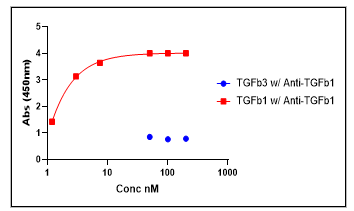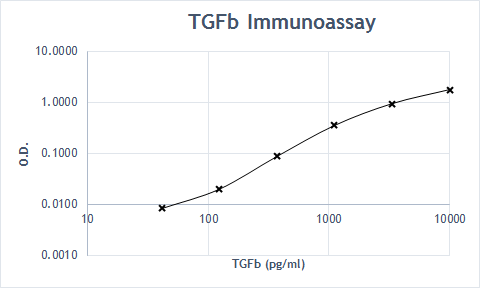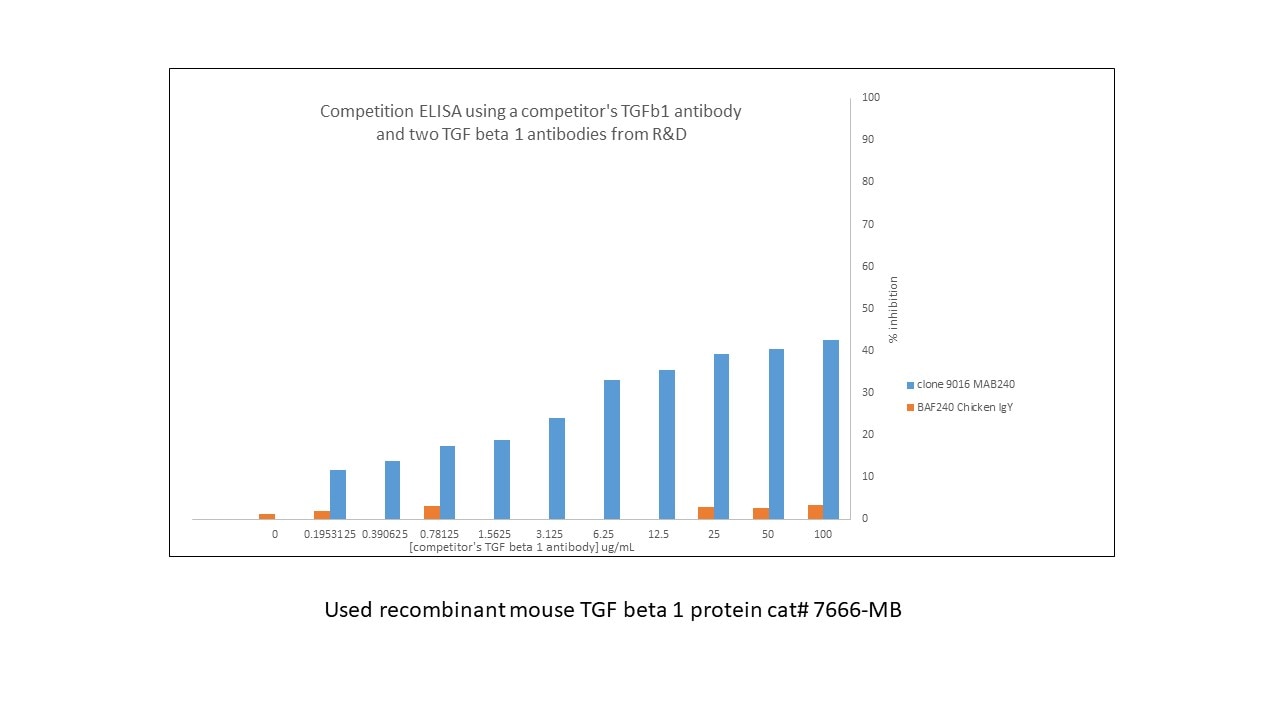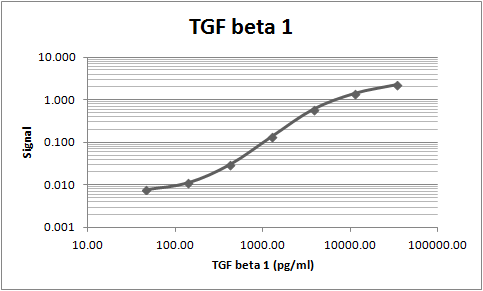TGF-beta 1 Biotinylated Antibody Summary
Applications
Human TGF-beta 1 Sandwich Immunoassay
Please Note: Optimal dilutions should be determined by each laboratory for each application. General Protocols are available in the Technical Information section on our website.
Reconstitution Calculator
Preparation and Storage
- 12 months from date of receipt, -20 to -70 °C as supplied.
- 1 month, 2 to 8 °C under sterile conditions after reconstitution.
- 6 months, -20 to -70 °C under sterile conditions after reconstitution.
Background: TGF-beta 1
TGF- beta 1 (transforming growth factor beta 1) is one of three closely related mammalian members of the large TGF-beta superfamily that share a characteristic cystine knot structure (1 - 7). TGF-beta 1, -2 and -3 are highly pleiotropic cytokines that are proposed to act as cellular switches that regulate processes such as immune function, proliferation and epithelial-mesenchymal transition (1 - 4). Each TGF-beta isoform has some non-redundant functions; for TGF-beta 1, mice with targeted deletion show defects in hematopoiesis and endothelial differentiation, and die of overwhelming inflammation (2). Human TGF-beta 1 cDNA encodes a 390 amino acid (aa) precursor that contains a 29 aa signal peptide and a 361 aa proprotein (8). A furin-like convertase processes the proprotein to generate an N-terminal 249 aa latency-associated peptide (LAP) and a C-terminal 112 aa mature TGF- beta 1 (8, 9). Disulfide-linked homodimers of LAP and TGF-beta 1 remain non-covalently associated after secretion, forming the small latent TGF-beta 1 complex (8 - 10). Covalent linkage of LAP to one of three latent TGF-beta binding proteins (LTBPs) creates a large latent complex that may interact with the extracellular matrix (9, 10). TGF-beta is activated from latency by pathways that include actions of the protease plasmin, matrix metalloproteases, thrombospondin 1 and a subset of integrins (10). Mature human TGF-beta 1 shares 100% aa identity with pig, dog and cow TGF-beta 1, and 99% aa identity with mouse, rat and horse TGF-beta 1. It demonstrates cross-species activity (1). TGF-beta 1 signaling begins with high-affinity binding to a type II ser/thr kinase receptor termed TGF-beta RII. This receptor then phosphorylates and activates a second ser/thr kinase receptor, TGF-beta RI (also called activin receptor-like kinase (ALK) -5), or alternatively, ALK‑1. This complex phosphorylates and activates Smad proteins that regulate transcription (3, 11, 12). Contributions of the accessory receptors betaglycan (also known as TGF-beta RIII) and endoglin, or use of Smad-independent signaling pathways, allow for disparate actions observed in response to TGF-beta in different contexts (11).
- Derynck, R. and K. Miyazono (2008) Cold Spring Harbor Laboratory Press, 29.
- Dunker, N. and K. Krieglstein (2000) Eur. J. Biochem. 267:6982.
- Wahl, S.M. (2006) Immunol. Rev. 213:213.
- Chang, H. et al. (2002) Endocr. Rev. 23:787.
- Lin, J.S. et al. (2006) Reproduction 132:179.
- Hinck, A.P. et al. (1996) Biochemistry 35:8517.
- Mittl, P.R.E. et al. (1996) Protein Sci. 5:1261.
- Derynck, R. et al. (1985) Nature 316:701.
- Miyazono, K. et al. (1988) J. Biol. Chem. 263:6407.
- Oklu, R. and R. Hesketh (2000) Biochem. J. 352:601.
- de Caestecker, M. et al. (2004) Cytokine Growth Factor Rev. 15:1.
- Zuniga, J.E. et al. (2005) J. Mol. Biol. 354:1052.
Product Datasheets
Citations for TGF-beta 1 Biotinylated Antibody
R&D Systems personnel manually curate a database that contains references using R&D Systems products. The data collected includes not only links to publications in PubMed, but also provides information about sample types, species, and experimental conditions.
45
Citations: Showing 1 - 10
Filter your results:
Filter by:
-
Heligmosomoides polygyrus Infection Can Inhibit Colitis through Direct Interaction with Innate Immunity
Authors: Long Hang, Tommy Setiawan, Arthur M. Blum, Joseph Urban, Korynn Stoyanoff, Seiji Arihiro et al.
The Journal of Immunology
-
Impact of Dietary Lavender Essential Oil on the Growth and Fatty Acid Profile of Breast Muscles, Antioxidant Activity, and Inflammatory Responses in Broiler Chickens
Authors: Shimaa A. Amer, Ahmed A. A. Abdel-Wareth, Ahmed Gouda, Gehan K. Saleh, Arwa H. Nassar, Wafaa R. I. A. Sherief et al.
Antioxidants (Basel)
-
Heligmosomoides polygyrus bakeri Induces Tolerogenic Dendritic Cells that Block Colitis and Prevent Antigen-Specific Gut T Cell Responses
Authors: Arthur M. Blum, Long Hang, Tommy Setiawan, Joseph P. Urban, Korynn M. Stoyanoff, John Leung et al.
The Journal of Immunology
-
Severity of the TGN1412 trial disaster cytokine storm correlated with IL-2 release
Authors: David Eastwood, Chris Bird, Paula Dilger, Jason Hockley, Lucy Findlay, Stephen Poole et al.
British Journal of Clinical Pharmacology
-
A Curative Immune Profile One Week after Treatment of Indian Kala-Azar Patients Predicts Success with a Short-Course Liposomal Amphotericin B Therapy
Authors: Smriti Mondal, Pradyot Bhattacharya, Mehebubar Rahaman, Nahid Ali, Rama Prosad Goswami
PLoS Neglected Tropical Diseases
-
T Cell Surveillance of Oncogene-Induced Prostate Cancer Is Impeded by T Cell-Derived TGF-beta 1 Cytokine
Authors: Moses K. Donkor, Abira Sarkar, Peter A. Savage, Ruth A. Franklin, Linda K. Johnson, Achim A. Jungbluth et al.
Immunity
-
On the Role IL-4/IL-13 Heteroreceptor Plays in Regulation of Type 1 Diabetes
Authors: TK Ukah, AN Cattin-Roy, W Chen, MM Miller, S Barik, H Zaghouani
J. Immunol., 2017-06-23;0(0):.
-
The Tyrphostin Agent AG490 Prevents and Reverses Type 1 Diabetes in NOD Mice
Authors: Abdoreza Davoodi-Semiromi, Clive H. Wasserfall, Chang Qing Xia, Rhonda M. Cooper-DeHoff, Martin Wabitsch, Michael Clare-Salzler et al.
PLoS ONE
-
Stromal regulation of vessel stability by MMP14 and TGFbeta
Authors: Nor E. Sounni, Kerstin Dehne, Leon van Kempen, Mikala Egeblad, Nesrine I. Affara, Ileana Cuevas et al.
Disease Models & Mechanisms
-
Murine CD4 T Cells Produce a New Form of TGF-beta as Measured by a Newly Developed TGF-beta Bioassay
Authors: Takatoku Oida, Howard L. Weiner
PLoS ONE
-
Transforming Growth Factor-Beta Produced by Non-small Cell Lung Cancer Cells Contributes to Lung Fibroblast Contractile Phenotype
Authors: N Kanaji, M Yokohira, N Watanabe, N Kadowaki, S Bandoh
Anticancer Res., 2018-04-01;38(4):2007-2014.
-
Canine Bone Marrow Derived Mesenchymal Stromal Cells Suppress Allo-Reactive Lymphocyte Proliferation in Vitro but Fail to Enhance Engraftment in Canine Bone Marrow Transplantation
Authors: Won Sik Lee, Yasuhiro Suzuki, Scott S. Graves, Mineo Iwata, G.M. Venkataraman, Marco Mielcarek et al.
Biology of Blood and Marrow Transplantation
-
FoxP3+RORgammat+ T helper intermediates display suppressive function against autoimmune diabetes
Authors: Danielle M. Tartar, Amie M. VanMorlan, Xiaoxiao Wan, F. Betul Guloglu, Renu Jain, Cara L. Haymaker et al.
The Journal of Immunology
-
Autocrine Transforming Growth Factor-beta 1 Promotes In Vivo Th17 Cell Differentiation
Authors: Ilona Gutcher, Moses K. Donkor, Qian Ma, Alexander Y. Rudensky, Richard A. Flavell, Ming O. Li
Immunity
-
Fungal sensing by dectin-1 directs the non-pathogenic polarization of TH17 cells through balanced type I IFN responses in human DCs
Authors: SI Gringhuis, TM Kaptein, EBM Remmerswaa, A Drewniak, BA Wevers, B Theelen, GRAM D'Haens, T Boekhout, TBH Geijtenbee
Nature Immunology, 2022-12-01;0(0):.
Species: Human
Sample Types: Cell Culture Supernates
Applications: ELISA Detection -
Targeting caveolae to pump bispecific antibody to TGF-beta into diseased lungs enables ultra-low dose therapeutic efficacy
Authors: AH Kadam, K Kandasamy, T Buss, B Cederstrom, C Yang, S Narayanapi, J Rodriguez, MD Levin, J Koziol, B Olenyuk, Z Borok, A Chrastina, JE Schnitzer
PLoS ONE, 2022-11-22;17(11):e0276462.
Species: Rat
Sample Types: In Vivo, Tissue Homogenates
Applications: Neutralization, Western Blot -
Inhibition of renal fibrosis with a human CXCL9‐derived glycosaminoglycan‐binding peptide
Authors: Fariba Poosti, Mohammad Ayodhia Soebadi, Helena Crijns, Alexandra De Zutter, Mieke Metzemaekers, Nele Berghmans et al.
Clinical & Translational Immunology
Species: N/A
Sample Types: Peptide
Applications: ELISA Detection -
Cancer immunotherapy via targeted TGF-&beta signalling blockade in TH cells
Authors: S Li, M Liu, MH Do, C Chou, EG Stamatiade, BG Nixon, W Shi, X Zhang, P Li, S Gao, KJ Capistrano, H Xu, NV Cheung, MO Li
Nature, 2020-10-21;0(0):.
Species: Mouse
Sample Types: Reference Standard
-
Circulating Picomolar Levels of CCL2 Downregulate Ongoing Chronic Experimental Autoimmune Encephalomyelitis by Induction of Regulatory Mechanisms
Authors: N Kaushansky, E Bakos, S Becker-Her, I Shachar, A Ben-Nun
J. Immunol., 2019-09-04;0(0):.
Species: Mouse
Sample Types: Cell Culture Supernates
Applications: ELISA Detection -
TGF??1 upregulates the expression of lncRNA?ATB to promote atherosclerosis
Authors: H Yu, S Ma, L Sun, J Gao, C Zhao
Mol Med Rep, 2019-03-29;19(5):4222-4228.
Species: Human
Sample Types: Serum
Applications: ELISA Development (Detection) -
Bifunctional immune checkpoint-targeted antibody-ligand traps that simultaneously disable TGF? enhance the efficacy of cancer immunotherapy
Authors: R Ravi, KA Noonan, V Pham, R Bedi, A Zhavoronko, IV Ozerov, E Makarev, A V Artemov, PT Wysocki, R Mehra, S Nimmagadda, L Marchionni, D Sidransky, IM Borrello, E Izumchenko, A Bedi
Nat Commun, 2018-02-21;9(1):741.
Applications: ELISA Development (Detection) -
Role of a Novel Human Leukocyte Antigen-DQA1*01:02;DRB1*15:01 Mixed Isotype Heterodimer in the Pathogenesis of "Humanized" Multiple Sclerosis-like Disease.
Authors: Kaushansky N, Eisenstein M, Boura-Halfon S, Hansen B, Nielsen C, Milo R, Zeilig G, Lassmann H, Altmann D, Ben-Nun A
J Biol Chem, 2015-04-24;290(24):15260-78.
Species: Mouse
Sample Types: Cell Culture Supernates
Applications: ELISA Development (Detection) -
Deltex1 antagonizes HIF-1alpha and sustains the stability of regulatory T cells in vivo.
Authors: Hsiao H, Hsu T, Liu W, Hsieh W, Chou T, Wu Y, Jiang S, Lai M
Nat Commun, 2015-02-19;6(0):6353.
Species: Mouse
Sample Types: Whole Cells
Applications: Flow Cytometry -
Induction and activation of latent transforming growth factor-beta1 are carried out by two distinct domains of pregnancy-specific glycoprotein 1 (PSG1).
Authors: Ballesteros A, Mentink-Kane M, Warren J, Kaplan G, Dveksler G
J Biol Chem, 2014-12-29;290(7):4422-31.
Species: Mouse
Sample Types: Cell Culture Supernates
Applications: ELISA Development (Detection) -
Oral Escherichia coli colonization factor antigen I fimbriae ameliorate arthritis via IL-35, not IL-27.
Authors: Kochetkova I, Thornburg T, Callis G, Holderness K, Maddaloni M, Pascual D
J Immunol, 2013-12-11;192(2):804-16.
Species: Mouse
Sample Types: Whole Cells
Applications: Flow Cytometry -
C-reactive protein promotes diabetic kidney disease in a mouse model of type 1 diabetes.
Authors: Liu F, Chen HY, Huang XR, Chung AC, Zhou L, Fu P, Szalai AJ, Lan HY
Diabetologia, 2011-07-09;54(10):2713-23.
Species: Human
Sample Types: Cell Culture Supernates
Applications: ELISA Development -
Depletion of TGF-beta from fetal bovine serum
Authors: Takatoku Oida, Howard L. Weiner
Journal of Immunological Methods
Species: Bovine
Sample Types: Serum, Cell Culture Supernates
Applications: ELISA Detection -
Stromal regulation of vessel stability by MMP14 and TGFbeta
Authors: Nor E. Sounni, Kerstin Dehne, Leon van Kempen, Mikala Egeblad, Nesrine I. Affara, Ileana Cuevas et al.
Disease Models & Mechanisms
Species: Mouse
Sample Types: Tissue Homogenates
Applications: Immunoprecipitation, ELISA Detection -
FoxP3+RORgammat+ T helper intermediates display suppressive function against autoimmune diabetes
Authors: Danielle M. Tartar, Amie M. VanMorlan, Xiaoxiao Wan, F. Betul Guloglu, Renu Jain, Cara L. Haymaker et al.
The Journal of Immunology
Species: Mouse
Sample Types: Whole Cells
Applications: Flow Cytometry -
Activation of Toll-like receptor 3 augments myofibroblast differentiation.
Authors: Sugiura H, Ichikawa T, Koarai A, Yanagisawa S, Minakata Y, Matsunaga K, Hirano T, Akamatsu K, Ichinose M
Am. J. Respir. Cell Mol. Biol., 2008-11-06;40(6):654-62.
Species: Human
Sample Types: Cell Culture Supernates
Applications: ELISA Development -
In vitro induction of mucosa-type dendritic cells by all-trans retinoic acid.
Authors: Saurer L, McCullough KC, Summerfield A
J. Immunol., 2007-09-15;179(6):3504-14.
Species: Porcine
Sample Types: Cell Culture Supernates
Applications: ELISA Development -
Antigen-induced regulatory T cells in HBV chronically infected patients.
Authors: Barboza L, Salmen S, Goncalves L, Colmenares M, Peterson D, Montes H, Cartagirone R, Gutierrez Mdel C, Berrueta L
Virology, 2007-07-23;368(1):41-9.
Species: Human
Sample Types: Whole Cells
Applications: Flow Cytometry -
Abnormal activation and cytokine spectra in lymph nodes of people chronically infected with HIV-1.
Authors: Biancotto A, Grivel JC, Iglehart SJ, Vanpouille C, Lisco A, Sieg SF, Debernardo R, Garate K, Rodriguez B, Margolis LB, Lederman MM
Blood, 2007-02-08;109(10):4272-9.
Species: Human
Sample Types: Cell Culture Supernates
Applications: Luminex Development -
Transforming growth factor beta 1(TGF-beta1) down-regulates TNFalpha-induced RANTES production in rheumatoid synovial fibroblasts through NF-kappaB-mediated transcriptional repression.
Authors: Cho ML, Min SY, Chang SH, Kim KW, Heo SB, Lee SH, Park SH, Cho CS, Kim HY
Immunol. Lett., 2006-03-03;105(2):159-66.
Species: Human
Sample Types: Cell Culture Supernates
Applications: ELISA Development -
trans fatty acids and systemic inflammation in heart failure.
Authors: Mozaffarian D, Rimm EB, King IB, Lawler RL, McDonald GB, Levy WC
Am. J. Clin. Nutr., 2004-12-01;80(6):1521-5.
Species: Human
Sample Types: Plasma
Applications: ELISA Development -
Conversion of peripheral CD4+CD25- naive T cells to CD4+CD25+ regulatory T cells by TGF-beta induction of transcription factor Foxp3.
Authors: Chen, WanJun, Jin, Wenwen, Hardegen, Neil, Lei, Ke-Jian, Li, Li, Marinos, Nancy, McGrady, George, Wahl, Sharon M
J Exp Med, 2003-12-15;198(12):1875-86.
Species: Mouse
Sample Types: Whole Cells
Applications: Flow Cytometry -
Th2 cytokine regulation of type I collagen gel contraction mediated by human lung mesenchymal cells.
Authors: Liu X, Kohyama T, Wang H, Zhu YK, Wen FQ, Kim HJ, Romberger DJ, Rennard SI
Am. J. Physiol. Lung Cell Mol. Physiol., 2002-05-01;282(5):L1049-56.
Species: Human
Sample Types: Cell Culture Supernates
Applications: ELISA Development -
Repeated exposure induces periportal fibrosis in Schistosoma mansoni-infected baboons: role of TGF-beta and IL-4.
Authors: Farah IO, Mola PW, Kariuki TM, Nyindo M, Blanton RE, King CL
J. Immunol., 2000-05-15;164(10):5337-43.
Species: Primate - Papio anubis (Olive Baboon)
Sample Types: Cell Culture Supernates
Applications: ELISA Development -
Inhibition of renal fibrosis with a human CXCL9‐derived glycosaminoglycan‐binding peptide
Authors: Fariba Poosti, Mohammad Ayodhia Soebadi, Helena Crijns, Alexandra De Zutter, Mieke Metzemaekers, Nele Berghmans et al.
Clinical & Translational Immunology
-
Activation of latent transforming growth factor-beta 1, a conserved function for pregnancy-specific beta 1-glycoproteins
Authors: James Warren, Michelle Im, Angela Ballesteros, Cam Ha, Tom Moore, Fanny Lambert et al.
MHR: Basic science of reproductive medicine
-
Muscleblind-like 1 is required for normal heart valve development in vivo
Authors: Ryan J. Coram, Samantha J. Stillwagon, Anuradha Guggilam, Michael W. Jenkins, Maurice S. Swanson, Andrea N. Ladd
BMC Developmental Biology
-
DQB1*0602 rather than DRB1*1501 confers susceptibility to multiple sclerosis-like disease induced by proteolipid protein (PLP)
Authors: Nathali Kaushansky, Daniel M Altmann, Chella S David, Hans Lassmann, Avraham Ben-Nun
Journal of Neuroinflammation
-
‘Multi-Epitope-Targeted’ Immune-Specific Therapy for a Multiple Sclerosis-Like Disease via Engineered Multi-Epitope Protein Is Superior to Peptides
Authors: Nathali Kaushansky, Nicole Kerlero de Rosbo, Rina Zilkha-Falb, Reut Yosef-Hemo, Lydia Cohen, Avraham Ben-Nun
PLoS ONE
-
The non-detergent sulfobetaine-201 acts as a pharmacological chaperone to promote folding and crystallization of the type II TGF-beta receptor extracellular domain
Authors: Kittikhun Wangkanont, Katrina T. Forest, Laura L. Kiessling
Protein Expression and Purification
-
Depletion of TGF-beta from fetal bovine serum
Authors: Takatoku Oida, Howard L. Weiner
Journal of Immunological Methods
FAQs
No product specific FAQs exist for this product, however you may
View all Antibody FAQsReviews for TGF-beta 1 Biotinylated Antibody
Average Rating: 4.8 (Based on 4 Reviews)
Have you used TGF-beta 1 Biotinylated Antibody?
Submit a review and receive an Amazon gift card.
$25/€18/£15/$25CAN/¥75 Yuan/¥2500 Yen for a review with an image
$10/€7/£6/$10 CAD/¥70 Yuan/¥1110 Yen for a review without an image
Filter by:
Dose response of TGFb1 and TGFb3, detection with Anti-TGFb1-biotin. Anti-TGFb1-biotin is specific for TGFb1 and no signal for TGFb3
I coated my plate with 50ng/well of recombinant mouse TGF beta 1 protein (cat# 7666-MB) overnight. I washed and blocked with reagent diluent 2 DY995 for 2hr, washed and added another company's TGFb1 antibody at different concentrations 0.2-100ug/mL in reagent diluent 2 and incubated 1hr. I did not wash my wells but add the two antibodies MAB240-biotinylated it in-house and BAF at a final concentration of 2ug/mL and incubated 1hr diluted in reagent diluent 2. I washed and added streptavidin-HRP DY998 (1:200) and incubated 30 mins, washed and developed with the substrate pack DY999. I found MAB240 competed for binding to the mouse TGF beta 1 protein when the competitor's antibody was present but the chicken polyclonal was not inhibited.













